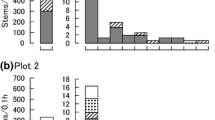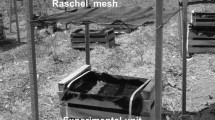Abstract
Positive associations between adult trees and understorey species have been explained either by direct or indirect facilitation. We tested both models by comparing the performance of two understorey species with contrasted stress-tolerance abilities Galium odoratum and Deschampsia flexuosa. Individuals of both species were transplanted in the four combinations of two treatments (gap and removal of an herbaceous competitor, Molinia caerulea). Our experiment demonstrated that direct facilitation of adult trees may explain the restricted occurrence of the shade-demanding Galium within closed forest communities. In contrast, the shade-tolerant Deschampsia was subjected to additional competition within the forest, likely because adult trees had a higher negative effect on light availability and a similar negative effect on nitrogen availability within the forest than did Molinia in the gaps.
Similar content being viewed by others
References
M.P. Austin, Continuum conceptordination methods, and niche theory. Annu. Rev. Ecol. Syst. 16 (1985) 39-61
F.A. Bazzaz, The physiological ecology of plant succession. Annu. Rev. Ecol. Syst. 10 (1979) 351-371
E.L. Berlow, Strong effects of weak interactions in ecological communities. Nature 398 (1999) 330-334
F.H. Bormann and G.E. Likens, Pattern and Process in a Forested Ecosystem. New-York: Springer Verlag (1994).
J. Braun-Blanquet, G.D. Fuller and H.S. Conard, Plant Sociology. The Study of Plant Communities. New-York: Mc-Graw-Hill edn (1932).
R.W. Brooker and T.V. Callaghan, The balance between positive and negative plant interactions and its relationship to environmental gradients: a model. Oikos 81 (1998) 196-207
J.F. Bruno, J.J. Stachowicz and M.D. Bertness, Inclusion of facilitation into ecological theory. Trends Ecol. Evol. 18 (2003) 119-125
R.M. Callaway, Positive interactions among plants. Bot. Rev. 61 (1995) 306-349
R.M. Callaway, Positive interactions in plant communities and the individualistic-continuum concept. Oecologia 112 (1997) 143-149
R.M. Callaway, E.H. Delucia, D. Moore, R. Nowak and W.H. Schlesinger, Competition and facilitation: contrasting effects of Artemisia tridentata on desert vs montane pines. Ecology 77 (1996) 2130-2141
R.M. Callaway and S.C. Pennings, Impact of a parasitic plant on the zonation of two salt marsh perennials. Oecologia 114 (1998) 100-105
P. Choler, R. Michalet and R.M. Callaway, Facilitation and competition on gradients in alpine plant communities. Ecology 82 (2001) 3295-3308
F.E. Clements, Plant Succession: An Analysis of the Development of Vegetation. Washington: Carnegie Institution of Washington edn (1916).
J.H Connell and R.O. Slatyer, Mechanisms of succession in natural communities and their role in community stability and organization. Am. Nat. 111 (1977) 1119-1144
R. Moral del and A.F. Watson, Gradient structure of forest vegetation in the central Washington cascades. Vegetatio 38 (1978) 29-48
R.A. Dorich and D.W. Nelson, Ammonium measurement. Soil Sci. Soc. Am. J. 47 (1983) 833-836
H. Ellenberg, Physiologisches und ökologishes Verhalten derselben Pflanzenarten. Ber. Deutsch. Bot. Ges. 65 (1953) 351-362
B. Finegan, Forest succession. Nature 312 (1984) 109-114
H.A. Gleason, The individualistic concept of the plant association. Bull. Torrey Bot. Club 53 (1926) 7-26
J.B. Grace, On the measurement of plant competition intensity. Ecology 76 (1995) 305-308
J.P. Grime, Vegetation classification by reference to strategies. Nature 250 (1974) 26-31
H.A.L. Henry and L.W. Aarssen, On the relationship between shade tolerance and shade avoidance strategies in woodland plants. Oïkos 80 (1997) 575-582
M. Holmgren, M. Huston and M. Scheffer, The interplay of facilitation and competition in plant communities. Ecology 78 (1997) 1966-1975
S.H. Hurlbert, Pseudoreplication and the design of ecological field experiments. Ecol. Monogr. 54 (1984) 187-211
Joud D. 1997. Complexité morphogé né tique, historiqueet é cologique des ecosystems forestiers ‘hydromorphes’ des plateaux et terrasses du Bas–Dauphiné . PhD thesis, University of Grenoble.
J.S. King, K.S. Pregitzer, D.R. Zak, M.E. Kubiske and W.E. Holmes, Correlation of foliage and litter chemistry of sugar mapleAcer saccharumas affected by elevated CO2 and varying N availability, and effects on decomposition. Oikos 94 (2001) 403-416
L.R. Lawlor, Direct and indirect effects of n-species competition. Oecologia 43 (1979) 355-364
J.M. Levine, Indirect facilitation: Evidence and predictions from a riparian community. Ecology 80 (1999) 1762-1769
S.H. Levine, Competitive interactions in ecosystems. Am. Nat. 110 (1976) 903-910
X. Li and S.D. Wilson, Facilitation among woody plants establishing in an old field. Ecology 79 (1998) 2694-2705
P. Liancourt, R.M. Callaway and R. Michalet, Stress tolerance and competitive response ability determine the outcome of biotic interactions. Ecology 86 (2004) 1611-1618
T. Lippmaa, The unistratal concept of plant communities (The Unions). Am. Midland Nat. 21 (1939) 111-145
Ch.J. Lortie, R.W. Brooker, Ph. Choler, Z. Kikvidze, R. Michalet, F.I. Pugnaire and R.M. Callaway, Rethinking plant community theory. Oikos 107 (2004) 433-438
J.H. Markham and C.P. Chanway, Measuring plant neighbour effects. Funct. Ecol. 10 (1996) 548-549
R.P. McIntosh, The continuum concept of vegetation. Bot. Rev. 33 (1967) 130-187
R. Michalet and T. Philippe, Les Groupements acidiphiles (landes et pelouses) de l’étage subalpin des Monts Dore (Massif Central français): Syntaxonomie et potentialitiés dynamiques. Colloques Phytosociologiques 23 (1995) 433-471
R. Michalet, C. Rolland, D. Joud, D. Gafta and R.M. Callaway, Associations between canopy and understory species increase along a rainshadow gradient in the Alps: habitat heterogeneity or facilitation?. Plant Ecol. 165 (2002) 145-160
T.E. Miller, Direct and indirect species interactions in an early old-field plant community. Am. Nat. 143 (1994) 1007-1025
D.J. Mladenoff, Dynamics of nitrogen mineralization and nitrification in hemlock and hardwood treefall gaps. Ecology 68 (1987) 1171-1180
E.H. Murchie and P. Horton, Contrasting patterns of photosynthetic acclimation to the light environment are dependent on the differential expression of the responses to altered irradiance and spectral quality. PlantCell Environ. 21 (1998) 203-214
J.P. Pages and R. Michalet, A test of the indirect facilitation model in a temperate hardwood forest of the northern French Alps. J. Ecol. 91 (2003) 932-940
J.P. Pages, G. Pache, D. Joud, N. Magan and R. Michalet, Direct and indirect effects of shade on four forest tree seedlings in the French Alps. Ecology 84 (2003) 2741-2750
D.A. Peltzer and M. Köchy, Competitive effects of grasses and woody plants in mixed-grass prairie. J. Ecol. 89 (2001) 519-527
S.C. Pennings and R.M. Callaway, Impact of a parasitic plant on the structure and dynamics of salt marsh vegetation. Ecology 77 (1996) 1410-1419
J.C. Rameau, D. Mansion and G. Dumé, Flore forestiére Française 2. France: Montagues, Institut pour Ie Développement Forestier (1993).
G.H. Raschid and R. Schaeffer, Seasonal variation in the nitrogen mineralization and mineral nitrogen accumulation in two temperate forest soils. Pedobiologia 31 (1988) 381-390
P.B. Reich, M.G. Tjoelker, M.B Walker, D.W. Vanderklein and C.C.C. Buschena, Close association of RGR, leaf and root morphology, seed mass and shade tolerance in seedling of nine boreal tree species grown in high and low light. Funct. Ecol. 12 (1998) 327-338
E.L. Rice and S.K. Pancholy, Inhibition of nitrification by climax ecosystems. II. Additional evidence and possible role of tannins. Am. J. Bot. 60 (1973) 691-702
L. Stone and A. Roberts, Conditions for a species to gain advantage from the presence of competitors. Ecology 72 (1991) 1964-1972
K. Taylor, A.P. Rowland and H.E. Jones, Molinia caerulea (L.) Moench. J. Ecol. 89 (2001) 126-144
K. Tielbörger and R. Kadmon, Indirect effects in a desert plant community: is competition among annuals more intense under shrub canopies?. Plant Ecol. 150 (2000) 53-63
D. Tilman, Resource Competition and Community Structure. New Jersey, U.S.A: Princeton (1982).
J.H. Vandermeer, Indirect and diffuse interactions: complicated cycles in a population embedded in a large community. J. Theor. Biol. 142 (1990) 429-442
J.F. Weltzin and G.R. Mcpherson, Faciliatation of conspecific seedling recruitment and shifts in temperate savanna ecotones. Ecol. Monogr. 69 (1999) 513-534
R.E. Wheatley, R. McDonald and A. McSmith, Extraction of nitrogen from soils. Biol. Fertility Soils 8 (1989) 189-190
R.H. Whittaker, Vegetation of the Great Smoky Mountains. Ecol. Monogr. 26 (1956) 1-80
R.H. Whittaker, Vegetation of the Siskiyou moutains, Oregon and california. Ecol. Monogr. 30 (1960) 279-338
S.D. Wilson and P.A. Keddy, Species competitive ability and position along a natural stress/disturbance gradient. Ecology 67 (1986) 1236-1242
Author information
Authors and Affiliations
Corresponding author
Rights and permissions
About this article
Cite this article
Pagés, JP., Michalet, R. Contrasted Responses of Two Understorey Species to Direct and Indirect Effects of a Canopy Gap. Plant Ecol 187, 179–187 (2006). https://doi.org/10.1007/s11258-005-0976-x
Received:
Accepted:
Published:
Issue Date:
DOI: https://doi.org/10.1007/s11258-005-0976-x




